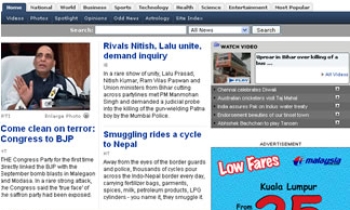Earlier this year, Wall Street analysts were ready to write obituaries for America Online Inc., which was losing dial-up Internet subscribers at a rate of 2 million per year. Now the Dulles-based service is suddenly at the heart of a bidding war among Google Inc., Microsoft Corp. and Yahoo Inc. because it has something they all want:
Eyeballs.
AOL is still losing subscribers, but it has radically altered its personality, re-creating itself as a network of free Web sites with an audience of 112 million users that is second in size to only Yahoo. Unlike in the 1990s, when online companies went broke trying to build audience size, today there is a thriving Internet advertising market that puts value on viewership. Ad rates go up as the audience grows, much like television.
AOL hits that sweet spot and gives the company new status in the battle for dominance on the Internet.
"They were left for dead, and now all of a sudden they are the prettiest girl at the dance," said Raymond Katz, an analyst with Bear, Stearns & Co. "You have to give them credit. It is Internet advertising that woke everybody up and the steps AOL has taken that have positioned it better."
"Everyone is interested in AOL," added Brian M. Prenoveau, an analyst with Muriel Siebert & Co. "It is amazing how it can go from almost nothing to something so big, from being a drag to being an object of desire."
For AOL employees, the news is not all so rosy, since AOL has slashed about 2,000 workers from the payroll as its dial-up business has contracted.
Yesterday, AOL fired about 700 more employees by closing its Orlando-based call center, which had 450 workers; dismissed dozens of executives at corporate headquarters in Northern Virginia; and gave pink slips to others who work for the company's subscriber service. "We need to reduce our costs in proportion to the decline in subscriber revenues," chief executive Jonathan Miller wrote in an e-mail to employees yesterday.
AOL's reduction in computer network expenses, and its payroll cuts, have enabled it to continue generating more than $1 billion annually in cash for parent Time Warner Inc.
The spark that has ignited interest in AOL was Miller's decision last year to move in a new direction by giving away AOL's content to grow its audience on AOL.com, Mapquest, Moviefone, Netscape.com and other free Web sites. Before that, with the exception of its popular AIM instant messaging service, AOL kept its entertainment, music, news and other content in a walled garden for subscribers only.
For their monthly fee, AOL subscribers still get dial-up Internet access whether they are at home or traveling, something high-speed providers do not offer. In addition, the only way to keep or get an AOL e-mail address is to be a subscriber. Other benefits range from parental controls to McAfee antivirus protection.
But with AOL's new emphasis on high-speed Internet users, the size of its network now trails only Yahoo's, which had about 121 million unique visitors in September, according to ComScore Networks. Coupled with the rapid increase in online advertising, which is growing at a double-digit rate, the shift to an audience-based strategy has AOL once again showing signs of growth, as it brings in hundreds of millions of dollars of revenue from ads.
Much of that increase is from ads served up by Google, which is the primary search engine for AOL and displays small, text-based ads alongside free Internet search results. Mark Cordover, chief executive of IT.com, a District-based business search engine, said Google wants to remain on the AOL network largely because the mass audience gives its well-known brand prominence.
Microsoft, for its part, has proposed that AOL parent Time Warner dump Google in favor of MSN Search and appears willing to pay billions of dollars for a stake in AOL to win the battle.
"Google doesn't want Microsoft elbowing its way into the search market," Cordover said. "That is why Google cares. This is a kind of brand threat."
AOL's growth has been augmented by its purchase of Baltimore-based Advertising.com, giving it an even bigger stake in the growth of online advertising and commerce. Buying a stake in AOL would not only allow Google or Microsoft to reach AOL's 20 million paying dial-up subscribers and visitors to its free Web sites, it would also assure one of them of access to the more than 50 million users of AOL's popular instant messaging service.
Despite its ups and downs -- from a federal probe into accounting irregularities to its ill-fated $112 billion merger with Time Warner that wiped out tens of billions of dollars of shareholder value -- America Online remains one of the best-known names on the Internet. That, analysts said, has facilitated its turnaround.
"Even though they have been losing a lot of subscribers, they are an awfully powerful brand," Prenoveau said. "The AOL brand name is still viable. It still resonates with a lot of people, and people can now go there for free the way they use Yahoo or Google to search or buy or instant message. There is growth potential there."









